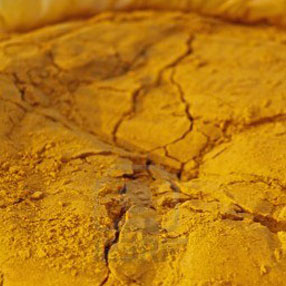

Tumeric

Turmeric is the boiled, dried, cleaned and polished rhizomes of Curcuma longa. The plant is a herbaceous perennial, 60-90 cm high, with a short stem and tufted leaf. There are 7 to 12 leaves, the leaf sheaths forms the pseudo stem. The lamina is green above and pale green below and has a length of 30-40 cm and width 8-12 cm. Inflorescence is a central spike of 10-15 cm length. 1-4 flowers are born in axil of the bract opening one at a time. About 30 flowers are produced in a spike. Seeds are produced in capsules and there will be one to numerous sunken capsules in an inflorescence.
Turmeric is used to flavour and to colour foodstuffs. It is a principal ingredient in curry powder. Turmeric oleoresin is used in brine pickles and to some extent in mayonnaise and relish formulations, non-alcoholic beverages, gelatins, butter and cheese etc. The colour curcumin extracted from turmeric is used as a colourant.
Turmeric is also used as a dye in textile industry. It is used in the preparation of medicinal oils, ointments and poultice. It is stomachic, carminative, tonic, blood purifier and an antiseptic. It is used in cosmetics. The aqueous extracts has biopesticidal properties.
Turmeric grows wild in the forests of South and Southeast Asia. It is one of the key ingredients for many Indian, Persian and Thai dishes such as in curry and many more. Ancient Indian medicine, Ayurveda has recommended its use in food for its medicinal value, much of which is now being researched in the modern day. Its use as a coloring agent is not of primary value in South Asian cuisine.
In Indonesia, the turmeric leaves are used for Minangese or Padangese curry base of Sumatra, such as rendang, sate padang and many other varieties.
Although most usage of turmeric is in the form of rhizome powder, in some regions (especially in Maharashtra, Goa, Konkan and Kanara), leaves of turmeric are used to wrap and cook food. This usually takes place in areas where turmeric is grown locally, since the leaves used are freshly picked. This imparts a distinct flavor.
In recipes outside South Asia, turmeric is sometimes used as an agent to impart a rich, custard-like yellow color. It is used in canned beverages and baked products, dairy products, ice cream, yogurt, yellow cakes, orange juice, biscuits, popcorn color, sweets, cake icings, cereals, sauces, gelatins, etc. It is a significant ingredient in most commercial curry powders. Turmeric is mostly used in savory dishes, as well as some sweet dishes, such as the cake sfouf.
Although usually used in its dried, powdered form, turmeric is also used fresh, much like ginger. It has numerous uses in Far Eastern recipes, such as fresh turmeric pickle, which contains large chunks of soft turmeric.
Turmeric (coded as E100 when used as a food additive, indicating how it is used as a food coloring since it normally gives food slightly yellow color) is used to protect food products from sunlight. The oleoresin is used for oil-containing products. The curcumin/polysorbate solution or curcumin powder dissolved in alcohol is used for water-containing products. Over-coloring, such as in pickles, relishes, and mustard, is sometimes used to compensate for fading.
In combination with annatto, turmeric has been used to color cheeses, yogurt, dry mixes, salad dressings, winter butter and margarine. Turmeric is also used to give a yellow color to some prepared mustards, canned chicken broths and other foods (often as a much cheaper replacement for saffron).
Turmeric is widely used as a spice in South Asian and Middle Eastern cooking. Many Persian dishes use turmeric as a starter ingredient. Almost all Iranian fried dishes typically consist of oil, onions and turmeric followed by any other ingredients that are to be included. In Nepal, turmeric is widely grown and is extensively used in almost every vegetable and meat dish in the country for its color, as well as for its medicinal value. In South Africa, turmeric is traditionally used to give boiled white rice a golden color.
